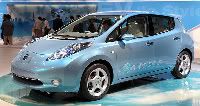Gating Factor for Consumer Adoption of Electric Vehicles
AltEnergyStocks.com wizard Tom Konrad comments on my piece on the gating factor for consumer adoption of electric vehicles:
I think the largest barrier is sticker shock.
Range anxiety does not stop anyone from buying the Volt, and Leafs are selling better. Where’s the range anxiety?
The problem with the Betamax analogy (i.e., that consumers are concerned about investing in what could be the automotive equivalent of the Betamax, a video technology that didn’t catch on) is that the problem with Betamax was you could not get videos to watch on it. With an EV, you will not have problems finding roads to drive on or electricity to fill up with (although speed of recharge can be an issue, but still it’s a problem any electrician can solve for you.)
I reply:
This is true; the Betamax analogy isn’t perfect, and for the exact reason you noted. But the underlying point is that part of the value equation for EV drivers is that the world of transportation truly is headed in this direction, as this brings along with it various other goodies: low-cost replacement batteries, ubiquitous Level 2 (240V) charging at the workplace and shopping, and eventually Level 3 (fast charging) on the major roadways. And yes, as you noted, the sticker price is currently attractive only to early adopters/environmentalists. But here too, we have prices coming down if we can get the volume to scale up.


Wish I were a wizard.
So many problems I’d love to magic away. Such as the sticker price on EVs, which is all about the price of batteries. I think you may be too quick to assume that higher volumes will lead to significantly lower prices on batteries. Yes, economies of scale and the manufacturing learning curve can lower prices, but only to a point, since a lot of the cost of batteries is not manufacturing costs, but raw materials. Learning curves work for solar because most of the cost is manufacturing cost. They don’t work for gasoline because most of the cost is the cost of petroleum.
According to A123 Systems most recent annual report, “Cost of product revenue includes the cost of raw materials, labor and components that are required for the production of our products, as well as manufacturing overhead costs (including depreciation), inventory obsolescence charges, and warranty costs. Raw material costs, which are our most significant cost item over the past two years, have historically been stable, but increasing energy costs for some of our materials are expected to increase this cost.
A123’s cost of product are 128% their selling price. So if raw materials are currently only 40% of manufacturing costs (I think that’s low, but I’m being charitable), then raw materials make up over half the selling price of A123’s batteries. Since other categories are not going to zero, there is only scope for a 20-30% reduction in the selling price of A123’s batteries unless raw materials prices also fall, which I do not expect (and neither does A123.)
What do you think of zinc-air, as represented, for instance, by these folks: http://2greenenergy.com/eos-energy-storage-2/15045/? They claim they’ll be selling product at $165/KWh next year.
I would agree about the sticker price. It’s what has kept me from both hybrids and electrics despite loving fuel efficient cars. My family has stuck to Fiestas and Focuses (Focii?) in the past to garner the gas mileage without the high cost. We’re mostly a one income family, so having two car payments really throws off our budget. We make up for it by having low gas costs (confession: I recently had a used Ford Mustang until I was in an accident – it was a midlife crisis mobile after my Saturn SL2 with the good gas mileage wore out).
Sort of related: where do you think the term “gating factor” comes from?